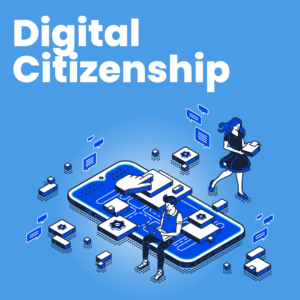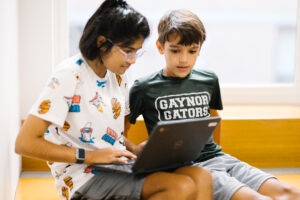 For the past decade, the Technology and Psychology Departments have worked together to implement a digital citizenship curriculum with an eye to staying current on both technology trends and healthy online practices. One key element of this initiative is including parents as partners with the school through the use of technology contracts and evening parent talks.
For the past decade, the Technology and Psychology Departments have worked together to implement a digital citizenship curriculum with an eye to staying current on both technology trends and healthy online practices. One key element of this initiative is including parents as partners with the school through the use of technology contracts and evening parent talks.
We sat down with Director of Technology & Operations Matthew LeWinter and Senior Consultant Dr. Clare Cosentino to ask them about the evolution of the digital citizenship curriculum, the partnership between Gaynor and parents, why parents need to pay attention to this issue, and how they can help their children live healthier digital lives.
Tell us about the history of the Digital Citizenship curriculum and parent partnership.
Mr. LeWinter
Our need for a digital citizenship presentation started initially with the Blue Cluster years ago, when we saw a need to attend to students’ digital habits, and how they interacted with technology. The social aspect of the digital world meant that some incidents would occur at home, and would then be brought into the school. The digital world can be a Wild West, and I don’t think parents know how to navigate it well, but the students do. They know better than us what’s out there.
The technology department has always been responsible for addressing technological issues, but we realized early on that the psychology team really should be there with us to handle the emotional side of these issues, and the partnership just formed. We started with reactive lessons, to issues that we had heard about or were made known to us, and then we started being more intentional about it. Over time, we expanded to the younger clusters, and we now have digital citizenship from the EC through Blue Cluster in age-appropriate shapes and forms. In the EC it could be about what does it mean to be a citizen, and being cooperative, and then up into Blue Cluster, we’re really talking about some more intense and personal subject matter.
Dr. Cosentino
We started a yearly presentation for parents nearly ten years ago because we saw that students were navigating a landscape in which they could stumble upon things that they had no boundaries, no understanding, and no responsible behavioral repertoire to navigate, and that we needed to teach them skills. Then at the same time, because so much of this went on outside of school, we needed to partner with parents because parents needed to understand what we all were really up against. As educators, we wanted to teach them what this landscape looked like, what their role is, and how we could work together because we can’t do this alone.
What does the current Digital Citizenship program look like? 
Mr. LeWinter
At the beginning of the year we have an acceptable use policy for the school that usually the older students read through. It’s more of a contract, and there’s a lot of discussion about what are contracts and how to read them. Mr. Russ or Mr. Levin will go through line by line and talk about expectations. For the younger clusters there are also charters or contracts, so there’s always a lot of discussion when it comes to how we’re going to use technology here at Gaynor, but also in life. The actual curriculum is usually around 2-8 weeks total, where the technology teacher/integrator will go in with part of the psychology team and be in the classroom and there’ll be different topics of discussion. And they’re partnering because while it may be the tech teacher that starts it off, it’s inevitable that there are some feelings and some heavy discussion that will go on, and that’s when the psychology team is really helpful.
Dr. Cosentino
We’re in the classrooms together for the digital citizenship component of the tech curriculum, which has been wonderful.
Mr. LeWinter
Yes, exactly. Additionally, this past summer we rewrote the whole technology curriculum and part of it was revamping the digital citizenship aspect, and creating more lessons to send home with the older students. That partnership connection also happens when there are discussion points with parents. For example, we had one that was a game and it would ask questions like, if you get an uncomfortable text, what do you do? And both the student and the parent would write their answers down, so we wanted the parents to be involved, and we’re doing that more and more.
Why is a home-school partnership important?
Mr. LeWinter
As a parent of a 10 year old, I’m seeing that if there’s not attention paid to digital practices at home, it can really go off the rails quickly. So I think that a lot of parents in their busy lives don’t necessarily have the initial time to focus and think about it, and so at Gaynor we help them with some tips and some thoughtfulness around what’s really going on out there. We’re focused on different applications, and the different issues that parents should really keep an eye on, and provide guidance for parents. As educators, we’re really hyper focused on what’s happening, so I think that has really been helpful, and it’s honestly been helpful for me in my personal life.
Dr. Cosentino
I agree. One of the things we as the psychology team love about working with the technology team is that they have a much better nuts and bolts understanding of devices and parental controls. They understand aspects of the landscape more than we do, but then we can come in and kind of give guidance from a psychological perspective, and also guide classroom discussions where we might stumble upon some very sensitive information. We work very closely together to support each other as teams and then also to bring this information to the parent body and to help them understand not only from a technological point of view, but also from a psychological and developmental point of view, how to best manage this major situation for our children.
A lot of what we do in the yearly presentation is give parents tips on what they can do at home whether it’s parental controls or setting time limits, and I think that guidance is helpful for parents because there’s a lot out there and it’s not always easy to find. Another thing that I think has been great about this program is that we really emphasize to the students that Gaynor is a safe place for them to talk about what they need to. When dealing with the digital landscape, there can be some uncomfortable moments that occur, and we want to make sure that students can approach any faculty or staff member here and talk about it. Maybe they don’t feel comfortable talking about it at home, so that’s where that partnership between Gaynor and parents also comes into play. And I think that we’ve been successful at that because I do find that the kids are very forthcoming and honest with us when it comes to their feelings about if they felt like they were being bullied or they’re just not comfortable with what’s happening online, and that’s been helpful with addressing issues.
How can parents set healthy boundaries while also trying to keep their children safe?
Mr. LeWinter
That’s the end goal right there. That’s what we’re looking to do. It’s all about having the students be in alignment with the parents. We always talk about not being punitive, and having a discussion about digital citizenship. An example I gave during this most recent talk was about the family contract and that before giving a student technology, a phone or a laptop or whatever it may be, to have that discussion and then discuss parameters around screen time, usage, appropriateness, and potential repercussions and things like that. It’s best to start early, but if not, you can always reset.
Dr. Cosentino
We like to start through the lens of wellness and really examine what is a healthy 24-hour day in a child’s life when you balance sleeping, eating, peer time, and homework and school, and then thinking where does technology fit into that? And having proactive conversations as opposed to reactive, so that before you buy that device, before you buy that smartphone, you set out the ground rules and say that their use of technology is not a private matter yet. Parents might say to their children, “You’re at this age where part of our job is to really monitor and to help you understand how to communicate in this new way. And that at your age these are not appropriate sites to go to or these are not appropriate social media platforms.” But parents need to talk about that before they hand the device over so it’s a conversation with expectations and ground rules that everybody agrees upon. And then you go from there. So we are all about being proactive rather than being in the moment and then becoming overwhelmed, and still allowing ourselves the grace to realize that perhaps we’ve given too much latitude — we have to pull back, and here’s why.
What are some first steps parents can take at home? 
Mr. LeWinter
First of all, I would say set expectations. If you want to give your child a device, then have that discussion and let the student or the child know that you are monitoring it and you have every right to do so.
Dr. Cosentino
Having those proactive conversations and the explanation as to why parents need to be involved is going to be helpful to them in their learning, but so is the recognition that they may sometimes feel that their privacy, depending on their age, is being infringed upon. But those are conversations to have, because I think at the end of the day it’s the communication and the cultivation of trust in the parent-child relationship that is going to make it more likely that your child will come to you when something is awry. Certainly that trust and that open communication is something we try to build at Gaynor, so there’s someone a student can go to if they are feeling over their head so they don’t have to navigate that alone.
You can find the slide deck from the Fall 2022 presentation here.

